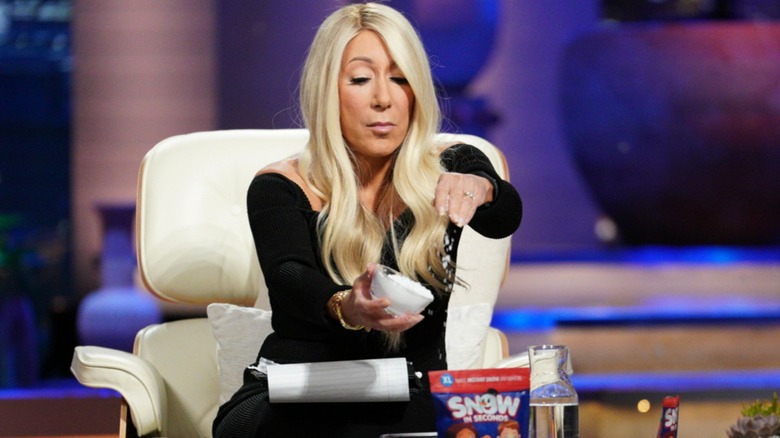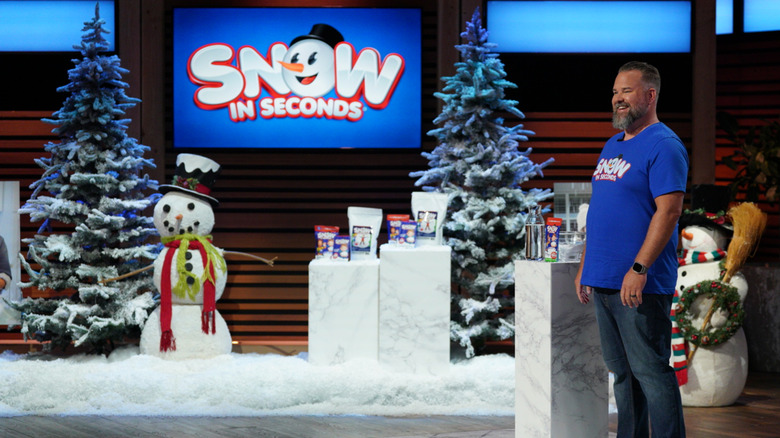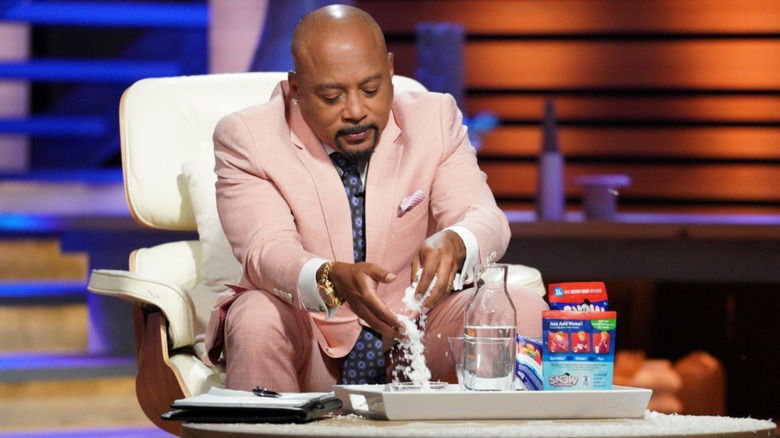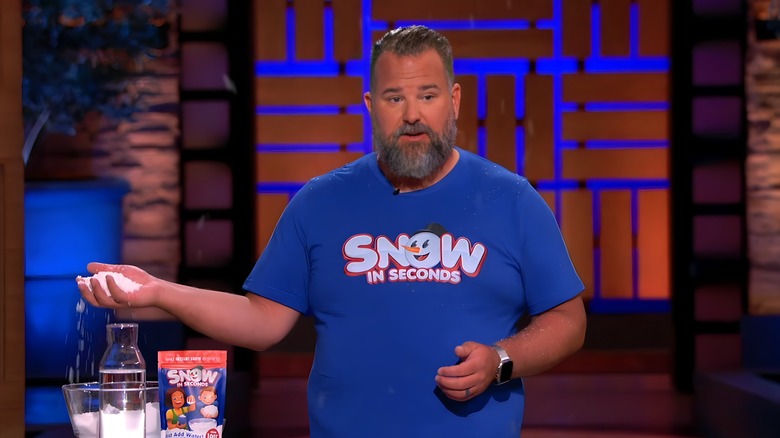3 Details To Know About Snow In Seconds From Shark Tank
"Shark Tank" is turning into a winter wonderland thanks to a certain new pitch that hews close to the spirit of the season. One of the various products featured on Season 15, Episode 8 is none other than Snow in Seconds, which offers users exactly what it says on the tin (or bag, in this instance). The company specializes in water-activated synthetic snow, allowing consumers to give any place, from a dollhouse to an entire front yard, a distinctly wintery touch — even if the seasonal weather isn't cooperating.
While some "Shark Tank" fans may already long be familiar with the concept of fake snow prior to Snow in Seconds' appearance on the series, there are a few interesting tidbits about this particular iteration of the product that are worth going over, including how it works and a certain surprising alternative use. Here's everything that interested viewers should know about Snow in Seconds.
Snow in Seconds works with the power of science
Like some other creative "Shark Tank" products, Snow in Seconds might seem like magic to those who don't yet know how it works. Indeed, the company's fake snow gets pretty close to the real deal, and some are no doubt wondering how exactly the product manages to replicate real snow so well. In truth, it's a relatively simple process. The fake snow is a synthetic polymer that starts out in a dry, powdered form. When the dehydrated grains of powder are exposed to water, they absorb a massive amount (roughly 100 times their size) and quickly balloon in volume, approximating the fluffy look and feel of snow.
Perhaps the most surprising element of Snow in Seconds is that it actually mirrors the cold nature of snow, even when used in conditions where regular snow would quickly melt away. Per Snow in Seconds' explanation in the frequently-asked-questions section of its site, the snow stays cool due to a constant process of evaporation that regulates the temperature. When the fake snow eventually does "melt" after a few days, it simply returns to its dehydrated, powdered form and can be repackaged and reused.
Snow in Seconds is a unique fake snow product
Snow in Seconds may be a novel concept, but fake snow is something that a decent few "Shark Tank" viewers may have encountered before — whether as a stocking stuffer, on the shelf of their local department store's toy section, or somewhere else. Despite this, Snow in Seconds purports to be the "original" patented supplier of instant snow.
Despite only appearing on "Shark Tank" in 2023, Snow in Seconds has actually been around for years, with the earliest post on its official Instagram account dating back to 2018. In that time, the company has built up a reputation as a well-established and well-known source of fake snow, as opposed to certain other brands that it labels as knockoffs. "Other brands try to sell the same substance in baby diapers and industrial cleaning supplies as instasnow or instant snow, beware of these rip off sites," a warning on the official site reads. Snow in Seconds claims that what sets their product apart from their competitors is how much their snow expands in size and that it maintains the appropriate texture.
Snow in Seconds can be used to make slime
While most consumers of Snow in Seconds are likely grabbing the product for the purpose of whipping up a little — or a lot — of fake snow, it also has an alternative use that offers a different sort of fun for both children and children-at-heart.
The company's website links to several YouTube videos of Santa Claus (perhaps one employed by Barbara Corcoran's HireSanta business) demonstrating the basics of mixing and using Snow in Seconds. However, one of these videos also showcases a special project that involves using Snow in Seconds to create a malleable handful of cloud slime. By combining a mixture of other ingredients and a heaping helping of instant snow, users can create a fluffy bit of slime to mess around with.
At the moment, it doesn't seem like Snow in Seconds has any official plans for any products besides batches of its instant snow. Nonetheless, it seems like creative customers can find multi-purpose uses for the snow when it comes to other crafts and projects.
What happened to Snow in Seconds on Shark Tank?
Jonathan Dusing makes a jolly entrance into the tank seeking $50,000 in exchange for 10% of Snow in Seconds. After a demonstration, it seems like he has the sharks mesmerized by his product. However, the holiday cheer begins to dissipate once they start questioning him about the business itself.
The sharks are impressed that Dusing has made roughly $2 million in lifetime sales, but worried about the fact that the company has been around for 15 years (there's also the issue that on $241,000 in sales for 2022 he only made roughly $40,000 in profit). Further compounding that concern is the fact that Snow in Seconds is actually a secondary venture for Dusing, who has a full-time gig running a sports technology business.
Lori Greiner compliments Snow in Seconds' branding but politely declines to make an offer. To the surprise of no one, Kevin O'Leary then goes full Grinch. He tells Dusing, "I hate it because it's seasonal, I hate it because the sales are abysmal and irrelevant, I hate the fact that it distracts you from a real business ... this deal sucks, I'm out."
Mark Cuban makes a more tactful exit from a potential deal, leaving just two sharks and not much in the way of hope for Dusing. However, a true Christmas miracle happens when Barbara Corcoran decides to "take a flyer" on Snow in Seconds, citing her success with other holiday-themed businesses like Hire Santa. She offers $50,000 for 33.3% and holds firm when Dusing tries to get her down to 25%. With Daymond John officially bowing out, Dusing accepts and leaves the tank with a deal in his stocking.



